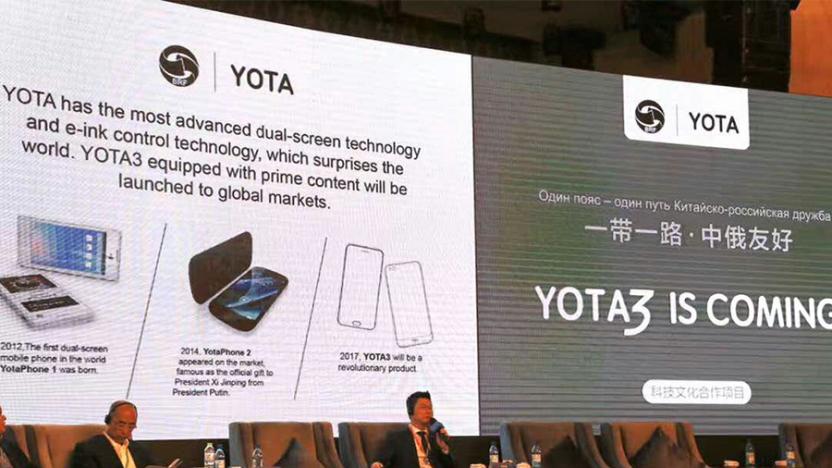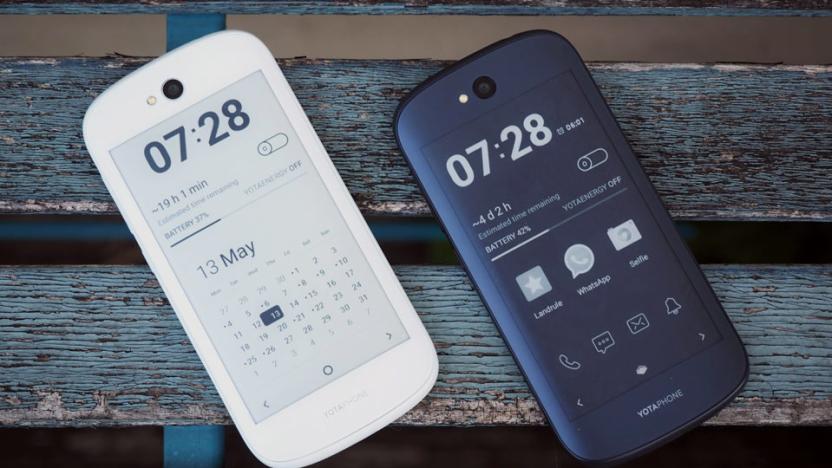yotadevices
Latest

'YotaPhone 3' isn't the dual-screen powerhouse you were expecting
If you're one of the few people who are still waiting for the next dual-screen YotaPhone, listen up: we finally have an update for you. During Harbin's China-Russia Expo over the weekend, Baoli Yota -- the joint venture formed by investor Baoli (formerly known as REX) and manufacturer Coolpad -- teased its upcoming "Yota3" with a date: it's due in the early fall later this year (almost four years since the launch of its predecessor) and will come with 64GB or 128GB of storage for a more favorable $350 or $450, respectively, according to RBC.

Yota aims for mass-market success after buyout
It's fair to say that the global launch of Yota Device's last E-Ink smartphone didn't quite go to plan. Despite positive reviews and a successful crowdfunding campaign, the Russian startup was forced to scale back its US plans significantly following a manufacturing issue. That sad state of affairs goes a long way to explaining why it's just accepted a large investment that puts a majority 64.9-percent stake in its company in the hands of Hong Kong-based investment company REX Global.

YotaPhone 2 gets whiter, cheaper and Lollipopier
The YotaPhone 2, with AMOLED on the front and E Ink on the back, is already quite a striking handset thanks to its dual-screen design. Though not striking enough, apparently, or at least not as openly eccentric as the new, white version of the device launching today. And a different color scheme isn't the only thing Yota Devices has to announce this morning. The price of the YotaPhone 2 is also dropping significantly in Europe from today, regardless of what model you're eyeing up, and all current owners will be pleased to hear that an update to Android 5.0 Lollipop has begun rolling out. In addition to Google's improvements, the new version also includes a bunch of YotaPhone-specific tweaks that let you do more with the E Ink display.

YotaPhone 2 review: niche and expensive, but seriously cool
YotaPhone was inarguably one of the quirkiest smartphones released last year, with not one, but two displays. This curious marriage of LCD and E Ink was certainly a manufacturing achievement, but limited uses for the secondary screen meant it simply couldn't live up to its potential. Undeterred, Yota Devices announced earlier this year it was cooking up a sequel, and today it's ready to launch the new and improved YotaPhone 2. Its fresh design, high-end specs and bigger, higher-resolution displays are welcome upgrades, but most importantly, a thorough overhaul of the handset's software means you can now make full use of the low-power E Ink screen, which has also been granted touch functionality for this generation. I've spent a fair amount of time with the device, and have to say that it's the most interesting smartphone I've ever used. Like its predecessor, the YotaPhone 2 is still very much a niche proposition with narrow mainstream appeal. That being said, Yota Devices has more or less achieved what it set out to do last year: Make a handset with an E Ink display that has several, legitimate use cases. Whether these will actually tempt you into picking one up is another matter, but the second screen is no longer an oddity; it's an asset.

Dual-display YotaPhone now shipping to the UK for £419
We're not entirely convinced that this is the right time to hop aboard the YotaPhone express, especially when a greatly improved second-gen handset has been promised before the end of this year. Nevertheless, if you're in the UK and you're willing to drop £419 in order to experiment with a genuinely unique e-reader / smartphone hybrid (as opposed to a phone that is e-ink only), then the Yota Devices web store will now ship to you via the source link below.

Dual-screen YotaPhone has a second shot at greatness
If you caught our review of the YotaPhone at the end of last year, you'll know we were cautious about recommending it -- in fact, we said it was probably safer to hold out for a second-gen device. Well, here's a surprise: that replacement is already at the prototype stage and it brings some big improvements that could undo many of the criticisms we leveled at the original. Most importantly, the rear E-Ink panel is now fully touch sensitive, which means you'll be able to do a lot more with this phone without ever needing to engage the traditional, power-hungry display on the other side. Calls, texts, emails, browsing, tweeting and more can be handled using the "always-on" 4.7-inch E-Ink display, with the only sacrifice being predictably slower refresh rates.

Hands-on with the YotaPhone: the e-ink Android phone that nobody expected
There was a moment, back in 2012, when we had some quiet doubts about the YotaPhone. The first prototype was desirable, useful, and far beyond any kind of gimmick -- but it also seemed like it'd be hard to manufacture for a reasonable price, especially by a company that has never built a phone before. After all, this is effectively two devices rolled into one: an LTE Android phone with a 4.3-inch LCD display on one side, plus an e-reader on the other side, offering always-on notifications from the OS and the luxury of over 60 hours of e-book reading time thanks to good old E Ink technology. Fortunately for us, and for any other phone lover on this planet who appreciates fresh ideas, such fears were unfounded. The Russian engineers at Yota Devices have overcome the many technical challenges that stood in their way, and the fruit of their efforts will go on sale in Europe later today via a dedicated online store, priced at a not-so-wacky 499 euros ($675). Admittedly, that may seem like a lot to ask if you focus solely on the specs -- like the 720p resolution of the LCD or the mid-range Snapdragon S4 Pro processor -- but it starts to make sense when you take a look at just how unique this thing is. And now that we're holding the final hardware in our hands, we're able to do just that.

Yota introduces Ruby LTE hotspot with e-ink display at CTIA 2013 (hands-on)
Remember Yotaphone, the twin-display Android smartphone (color LCD in front, e-ink in back)? Today at CTIA in Las Vagas, Yota devices, the company behind the innovative handset, introduced Ruby, a sleek LTE hotspot with a small e-ink screen. We don't usually get too excited about such devices, but Ruby looks like something out of Jony Ive's workshop, with some interesting features to match. The design recalls the iPod mini but is made of white plastic instead of aluminum. Along the top edge, you'll find the e-ink display and a two-way power switch -- slide it to the left and Ruby behaves like a secure hotspot, slide it to the right and it's a public access point. The e-ink screen shows battery and signal status, the number of connected devices and a smiley icon to confirm public mode. On the bottom edge is a trick flap that's both a micro-USB socket and a USB Type A plug depending on how it's positioned -- the micro-SIM slot is cleverly hidden behind it. A programmable RGB LED mounted behind the Yota logo completes the package on the front of the hotspot. Ruby currently supports quad-band EDGE, plus HSPA+ and LTE for the European market, but the radio can be configured (in hardware) to support other bands. The 2100mAh battery powers the unit for about 16 hours of use (60 hours on standby) and can be charged to 70 percent capacity in about an hour. Yota's signed a few deals with carriers in Russia and Europe and the device is expected to become available to Russian customers in two to three weeks for about $120 (unsubsidized). No word on whether Ruby will land in the US (yet). Take a look at our hands-on gallery below. %Gallery-189072%

YotaPhone Android prototype with dual LCD and E Ink displays hands-on (video)
Yesterday we brought you the announcement, and today we bring you the hands-on reality -- although bear in mind that this dual-screen YotaPhone is still very much a prototype. It certainly works -- pretty well, in fact -- but it's understandably rough around the edges and Yota Devices have plenty of work to do before the handset launches towards the end of next year. By way of a quick refresher: from the front this is a regular Android Jelly Bean phone with decent specs, including a 720 x 1,280 LCD display, dual-core 1.5GHz Snapdragon S4 processor, 2GB of RAM and a 12-megapixel main camera. Turn it around, however, and you reveal its double identity: a 200 dpi E Ink display which can hold a range of information -- calendar appointments, ebooks, tweets and whatever else you'd like -- without draining the battery. The good new is that the YotaPhone actually makes an even better first impression than we'd hoped, while the bad news is merely what's to be expected given the early stage of development. Click past the break for our hands-on video and impressions and all will become clear.

Russian YotaPhone promises dual 4.3-inch LCD and E Ink displays in Q3 of next year
Cast your mind back to IFA and you might just recall the appearance of a dual-screen mash-up device with no proper branding or launch date. Well, it so happens we've been in touch with the mystery phone's maker, Yota Devices -- a spin-off from the more established Russian telecoms company of the same name -- and we're assured that this is much more than a whimsical concept. The Android-based handset has now reached fully working prototype stage and bears a Gorilla Glass 4.3-inch 720 x 1,280 LCD display on the front, a 200dpi E Ink rear display of the same size and toughness, and a dual-core 1.5GHz Snapdragon S4 processor with 2GB of RAM and at least 32GB of non-expandable storage. There's even LTE, a 12-megapixel rear camera and a 720p front-facer to round things off, all housed in a 140 gram body that is less than 10mm thick. If things go to plan, the YotaPhone should arrive on Russian networks in Q3 of next year for an untold sum of money, and Yota says it's "in talks" with certain US and European carriers too. Read on for more.




